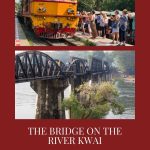A compelling WWII tour of the Thai-Burma Railway
The Thai-Burma Railway is just what the title says: a railway line between Burma (now called Myanmar) and Thailand. And it looks like pretty much any railway line anywhere. This particular line, though, has a dramatic and horrifying story to go with it, having to do with the Second World War, Japanese strategy, Western prisoners of war, and Asian laborers.
Disclosure: This day trip was sponsored by Thailand Journeys. Nevertheless, the company has no influence over what I write.
Another disclosure: This article contains affiliate links. If you click on one and make a purchase, I will receive a small commission. This will not affect your price.
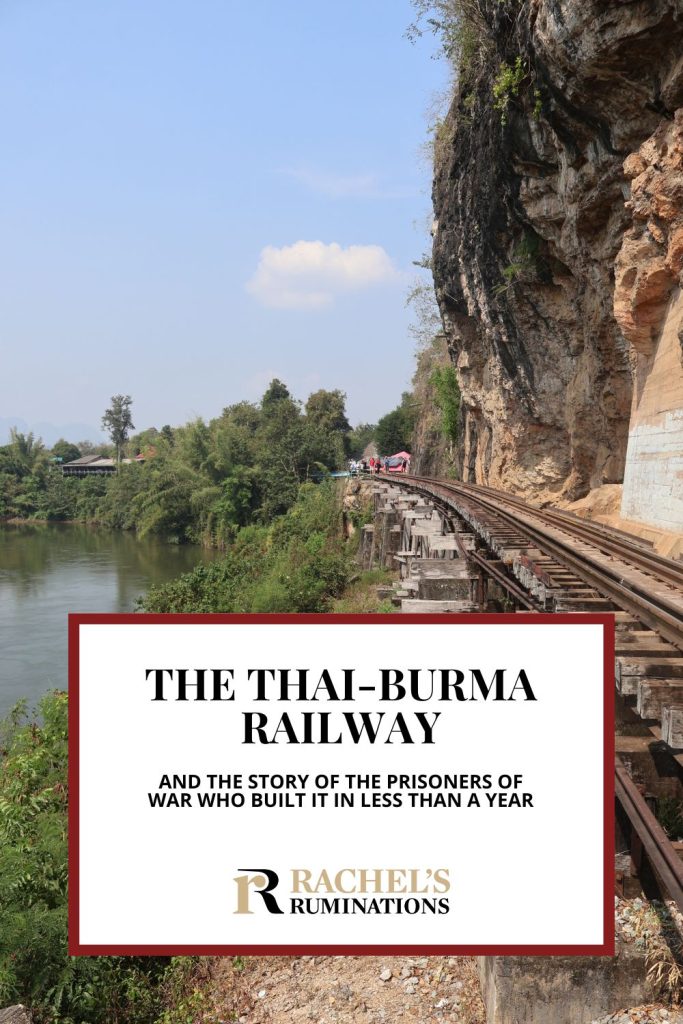
History of the Burma-Thai Railway
It was 1942, and the Empire of Japan had just defeated Thailand. Burma was next on its list, but this took longer; there was more resistance.
Why did the Japanese want to build the Thai-Burma Railway?
In order to supply its forces fighting in Burma, Japan had to use the sea route, which was quite long and vulnerable to Allied submarine attacks. They decided instead to build a railway line between Rangoon and Bangkok, or rather to connect existing railway lines in each country by adding 258 miles (415 km) of track between them. The route, already mapped out in the 19th century by the British, included some very hilly jungle terrain and a number of river crossings as well.
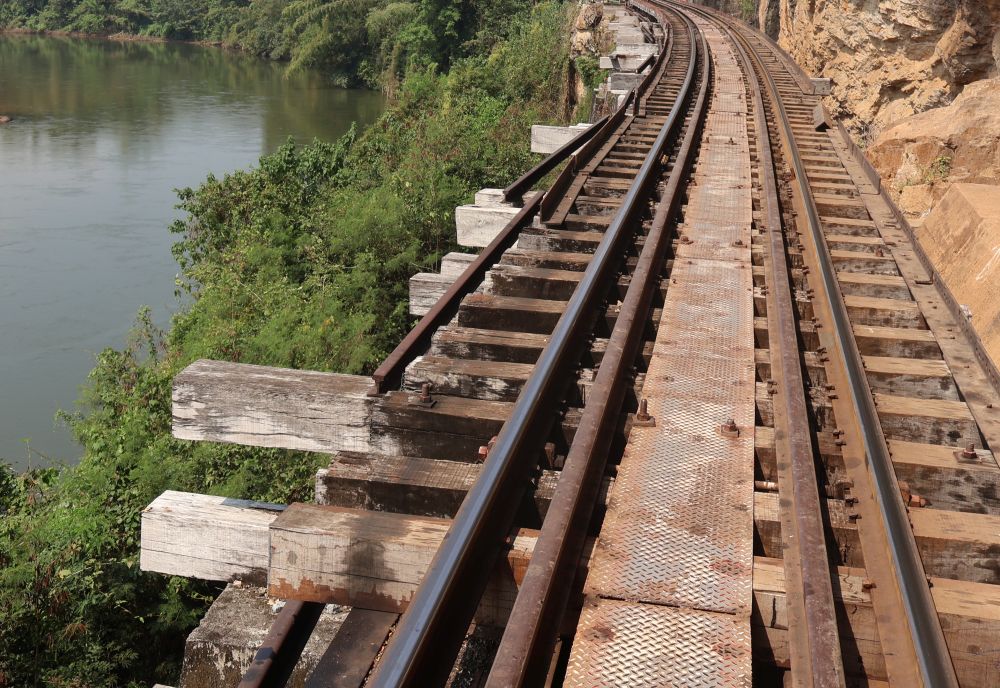
The Japanese were in a hurry, planning to build the railway in a year and a half, from June 1942 to December 1943. They supplied the project with workers by moving Allied prisoners of war and Asian laborers from all over Southeast Asia to work camps along the planned route. By forcing them to do hard manual labor, they even finished it ahead of schedule: in October 1943.
This rather dry account of the construction doesn’t portray the feat of engineering the railway entailed, nor the brutal nature of the project. There were over 600 bridges and the men did the job mostly with simple hand tools like hammers, pickaxes and spades. In places, they had to cut mountainsides to create a flat bed for the track. In others, workers risked their lives building bridges over steep hillsides. The men had to carry tree trunks, lengths of tracks, and so on by hand.
Who built the Thai-Burma Railway?
There were two groups of workers doing this task. The first was primarily Australian, Dutch and British prisoners of war, who lived in appalling conditions along the rail route. Simple bamboo shacks served as barracks. The meagre diet they received was nowhere near sufficient for the amount of work they were expected to complete. Many died from diseases like malaria, cholera and dysentery, if they didn’t die from the maltreatment they experienced at the hands of the Japanese (and some Korean) guards, injuries on the job, or simple malnutrition. There were about 61,000 of these POWs, according to Wikipedia, and about 16,000 of them died.
The other group of workers were civilians, called romusha. They were Malays, Burmese, Chinese, Thai, or other Southeast Asians and at first they were lured to the project with promises of good pay. When that didn’t provide enough workers, the Japanese started forcing workers to the project. This group of workers lived and labored in even worse conditions than the POWs, and had higher death rates as a result. Out of about 250,000 Asian laborers, about 90,000 died.
The Japanese forces who supervised the project, it seems, ranged the gamut from sympathetic but powerless to outright cruel and sadistic. They were marginally better housed and fed than the men they supervised, but quite a few of them also fell ill and died from various tropical diseases.
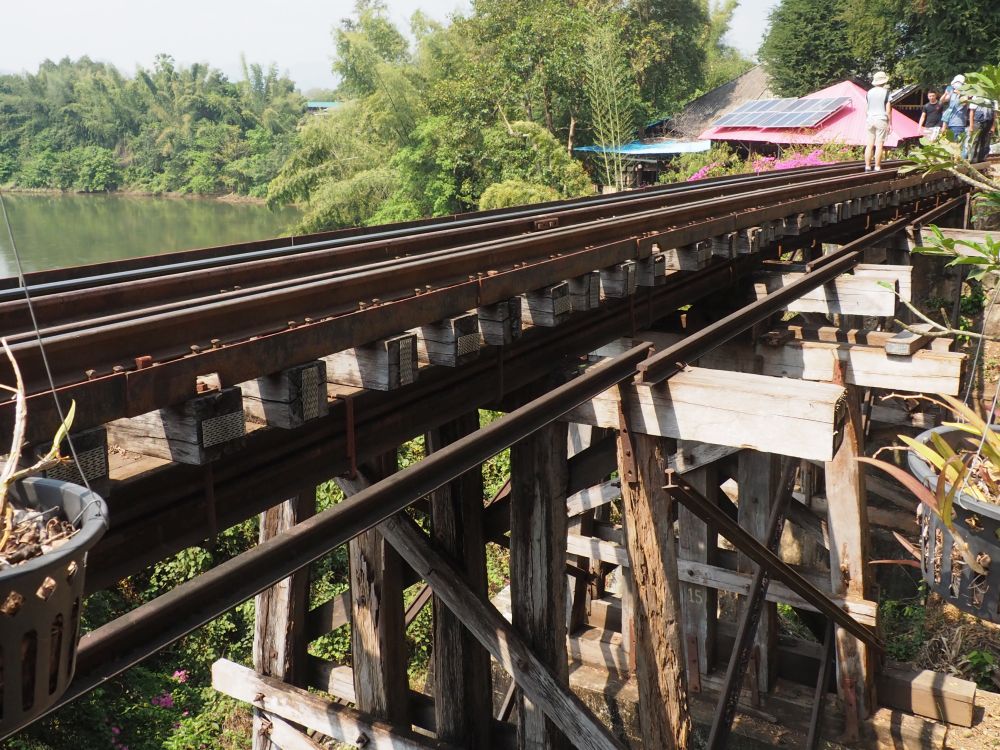
Thailand Journeys tour to Kanchanaburi
I learned about this piece of history on a private tour with Thailand Journeys, taking a full day. My husband and I traveled in a late-model car with a driver and a guide. It was comfortable and air-conditioned. The guide was great at explaining the history and answering our many other questions about life in Thailand and the things we passed along the way. While the tour was generally billed as a day trip to Kanchanaburi to see the Bridge on the River Kwai, it included stops at several other historical sites related to the “Death Railway” and its history.
Kanchanaburi War Cemetery
Our first stop, you could say, told the end of the story. There are actually three cemeteries in the area for the POWs who died building the Thai-Burma Railway. We stopped at the one in the town of Kanchanaburi, which the Commonwealth War Graves Commission (CWGC) maintains. It reminded me of some of the World War I and II cemeteries I’ve seen in Europe, also maintained by the CWGC: neat rows of gravestones, well-maintained and planted with flowers. In this case, the stones are low metal markers.
The 6900 men buried here are Commonwealth – mostly British or Australian – and Dutch servicemen. (The American soldiers who died were repatriated.) I found the Australian grave markers particularly touching because, in addition to the person’s name, rank, battalion, and death date, some had a short personal message like this one on Private F.M. Long’s stone: “At peace – loving husband of Dorothy, loved son of Martin & Jane Long … R.I.P.”
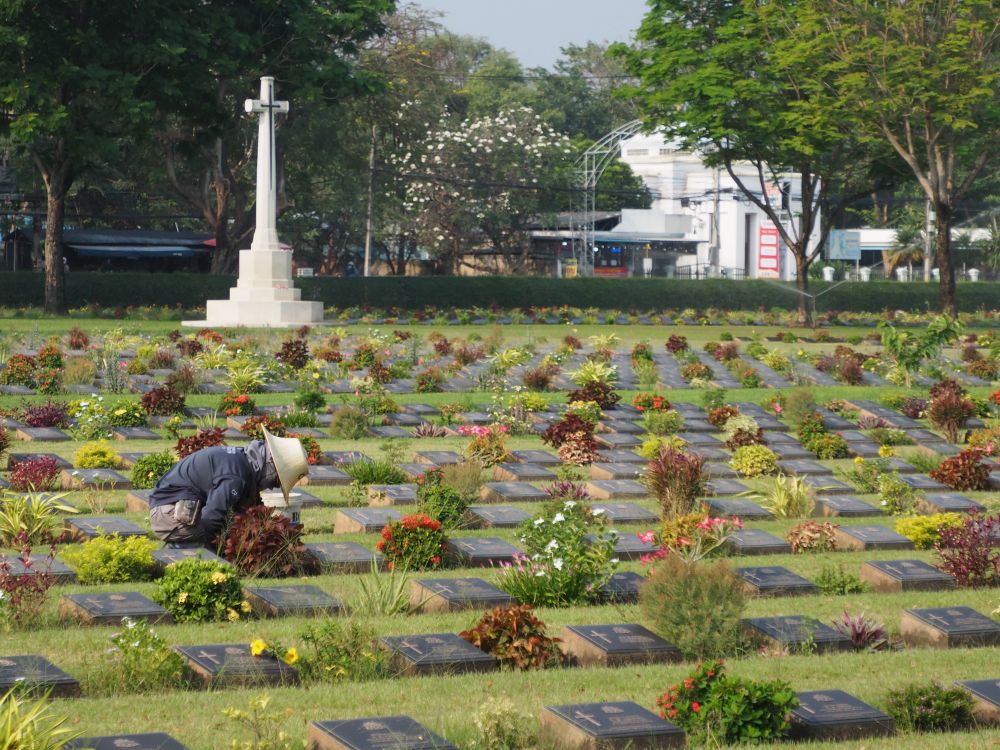
JEATH War Museum
JEATH is an acronym for the countries involved in building the railway: Japan, England, America, Australia, Thailand and Holland, but this museum is sometimes called the Death Railway Museum. It tells the story of the railway, and particularly of the Bridge on the River Kwai. That wooden bridge, built by these forced laborers, was destroyed toward the end of the war, but a remnant of one end of the original bridge is still in place at this museum.
The museum contains all sorts of relics from the war: boxcars from the trains, various other vehicles, helmets, cooking pots, tools, and so on. There are also collections of other items that only connect tangentially to the story – it seems to be, to some extent, one of those museums that exists to hold someone’s collection.
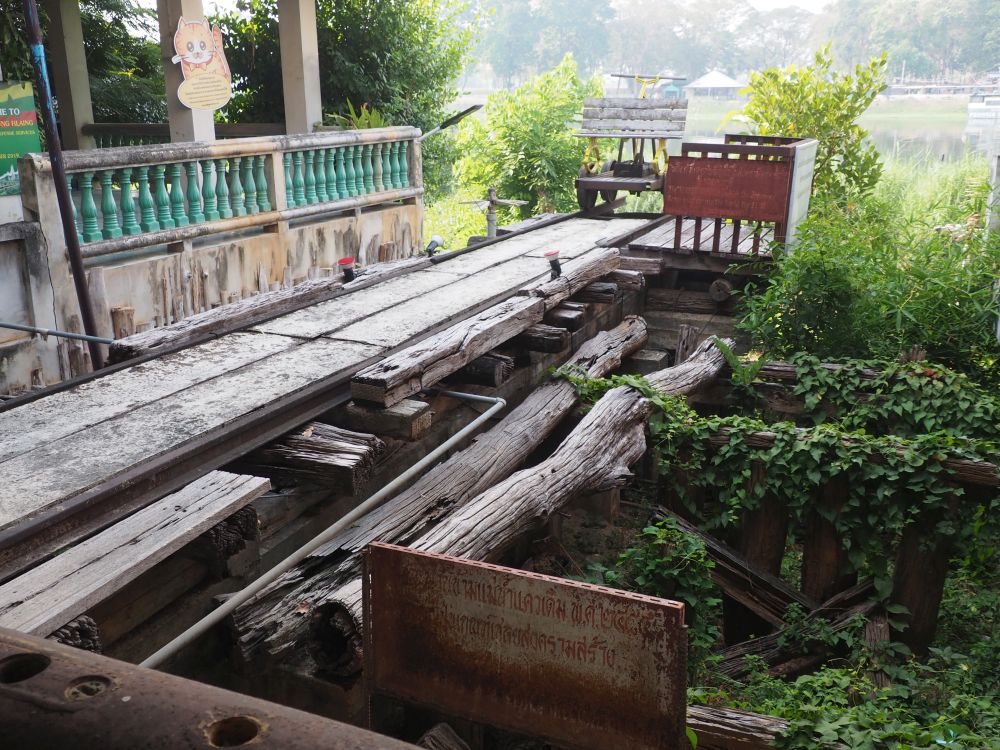
The Bridge on the River Kwai
We could see the more modern steel replacement for the original River Kwai Bridge from the museum, and we went to see it more closely as our next stop. I didn’t realize until we got to this famous bridge that it is still a working rail line. The Thai-Burma railway line still exists, though these days it does not extend into Myanmar and the State Railway of Thailand operates it. We could walk on the tracks onto the bridge.
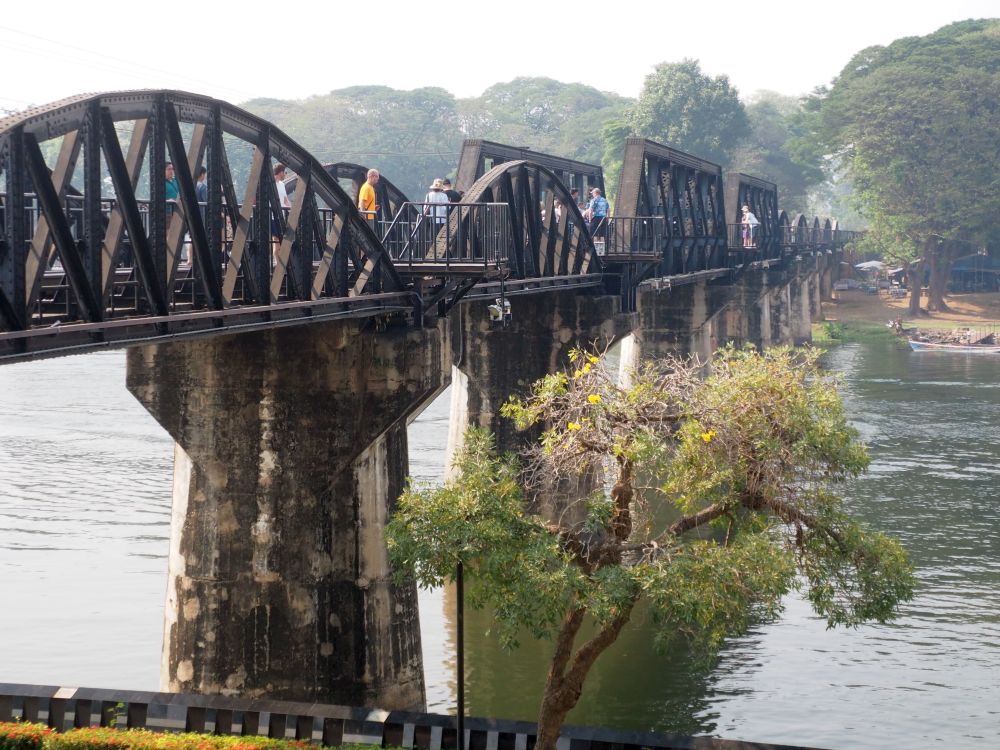
A train ride on the infamous Death Railway
It was just a short wait before a train arrived at the little train station next to the bridge, blowing a horn that I described as sounding like a very sick elephant. Clambering aboard, we settled into a set of four seats for the three of us – the two of us and our tour guide. It took a while to get started as the train wheezed its horn at tourists on the tracks. Eventually we got going.
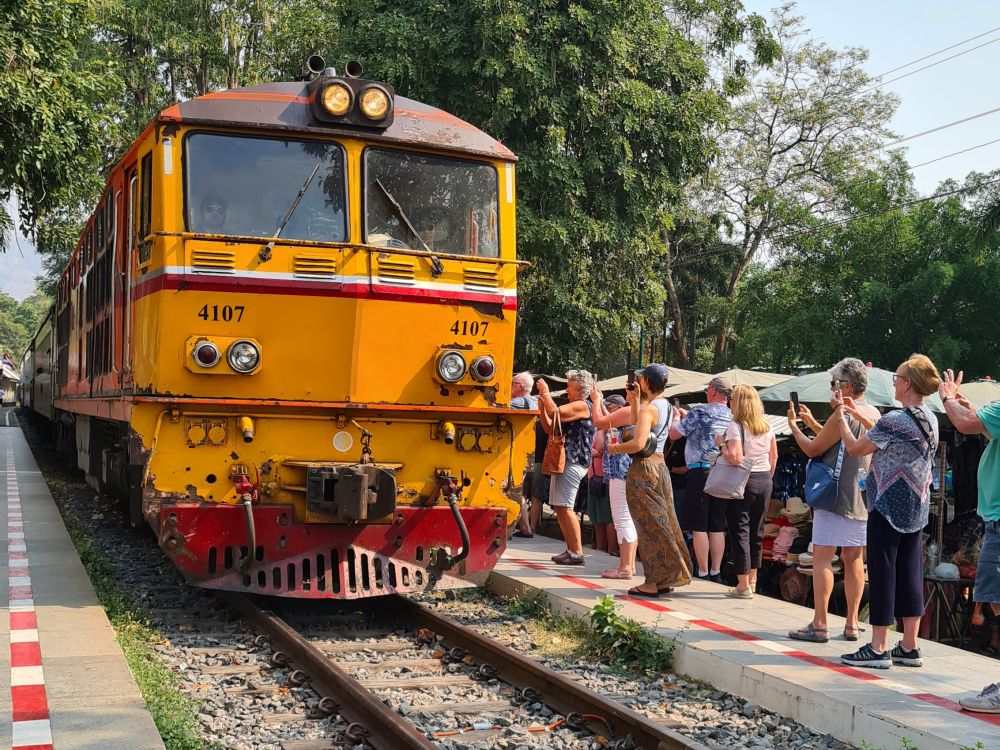
The first part of the trip passed through a flat agricultural landscape with low hills in the background. For what appeared to be quite an old train, we rattled along quite quickly, stopping at a few stops along the way. This line is not just for tourists; it serves some nearby communities too. Later in the ride the route started cutting along the side of a hill; we could see the deep Kwai river valley below us on one side and a jagged rock face on the other. It was sobering to think that forced laborers built this by hand.
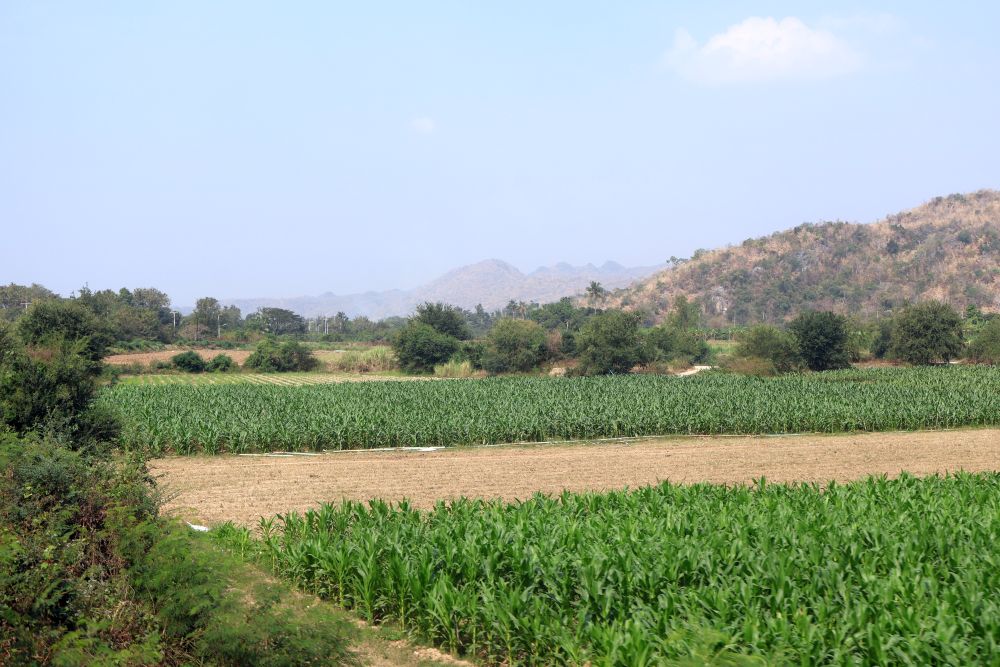
Krasae Cave
It was about an hour and a half trip before we got off at the Tham Krasae station next to a cave in the rock face. Krasae Cave was not carved by the POWs or the romusha. It’s a natural cave and the laborers used it as a camp – a place of quiet and coolness.
This was a particularly hard place to build the line. The rock hill had to be cut to vertical, but also a platform had to be built that hugged that rock face – essentially a very long bridge supports the railway here. Building it was extra dangerous as well because of the steep profile of the land. A wrong step, carrying one of the many hardwood poles for holding up the tracks, and you would plunge down the hill to your death.
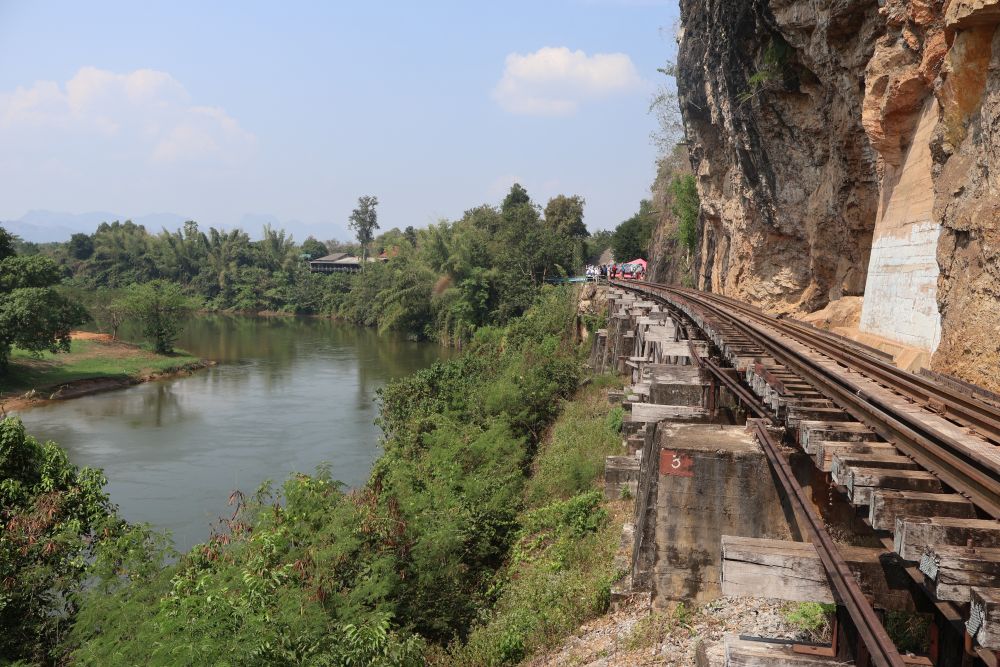
The cave today is both a tourist attraction and a shrine, with a large Buddha image. Visitors can walk along the tracks as well, both to see the views over the river valley and to appreciate the original structure, built by the POWs, that still supports the tracks.
After a very pleasant lunch in a nearby restaurant with a view over the river valley, we walked to where our car and driver waited for us and set off for our last stop.

Hellfire Pass
If one section of the Burma-Thailand Railway was the worst, it was Hellfire Pass. This section is a deep cutting through rock. The POWs and Asian laborers worked on it 18 hours a day in order to speed up completion of the line. Apparently it would have made more sense and taken fewer man-hours to dig a tunnel, but because the Japanese wanted to complete the line as soon as possible, they wanted to be working on the whole length of the pass simultaneously. That meant making a cutting rather than a tunnel. It got the name “Hellfire Pass” because of how it looked at night – lit by flaming torches, starving workers slaved at the rockface. It looked like Hell.
Today there is no railroad here; the current line runs from Bangkok to Nam Tok station and no further. But the Hellfire Pass Interpretive Centre, often called the Hellfire Pass Memorial Museum, is about 40 minutes from Krasae Cave and half that from Nam Tok station. It’s definitely worth a visit. A simple building with just a very few rooms, it still manages to hammer home how much the people building this railway suffered.
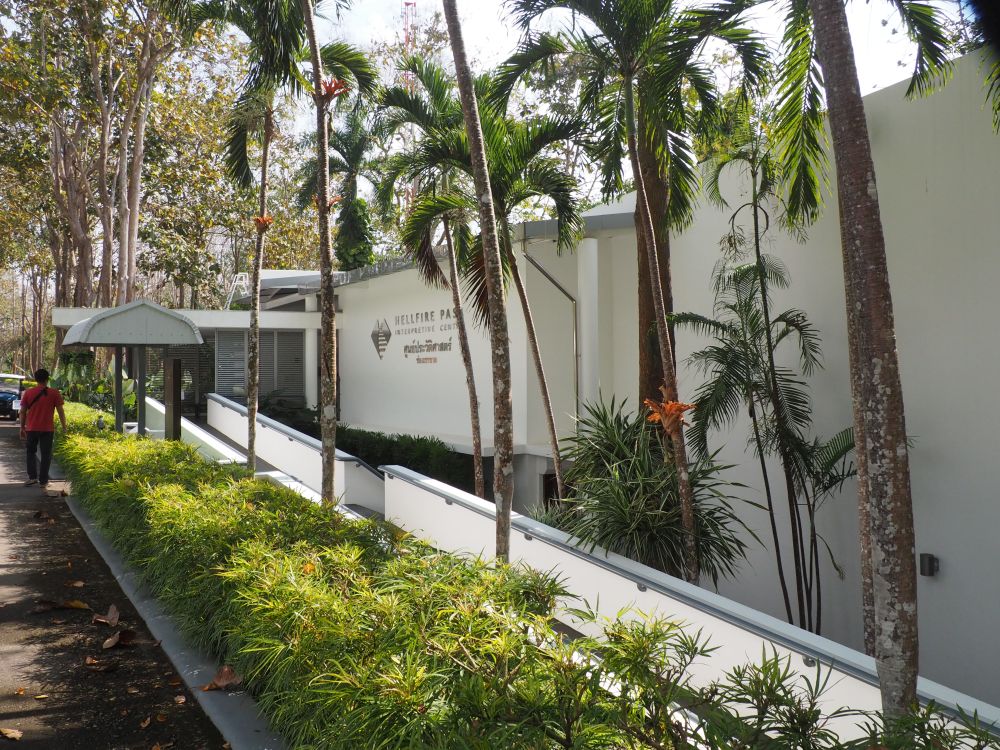
Besides just presenting the history in printed signs with text and pictures, what I found most moving were the many videos of Australian survivors telling about their experiences. (The museum is sponsored by the Australian government as well as the Thai army.) It’s appalling and fascinating to hear the little details they recount of their lives in the railway camps and their suffering at the hands of the Imperial Japanese Army. There were even some stories of small acts of resistance and heroism: of trying to slow the completion of the line. While the focus is on the Australian soldiers’ involvement, the other Allied POWs and the Asian labourers are not forgotten.
Normally, a trip to the Hellfire Pass Museum includes a short hike to – and through – the cutting itself. It’s a 20-minute or so walk to get to the memorial at Hellfire Pass. If you want to walk the whole cutting, it’s three kilometers long (almost 2 miles), and you’d need to walk the same route back, so expect to spend something like three hours. Bring water!
However, the day we visited, there was a bushfire happening in the valley, so the trail was closed. We stayed a while to watch the fire, which we could see not far away from the museum through the trees. The burning bamboo was particularly loud as it burned, and we watched a tanker truck spray water on it while the museum’s employees swept the ground free of dry leaves. Somehow watching and hearing the woods burn seemed fitting at a place called Hellfire Pass.
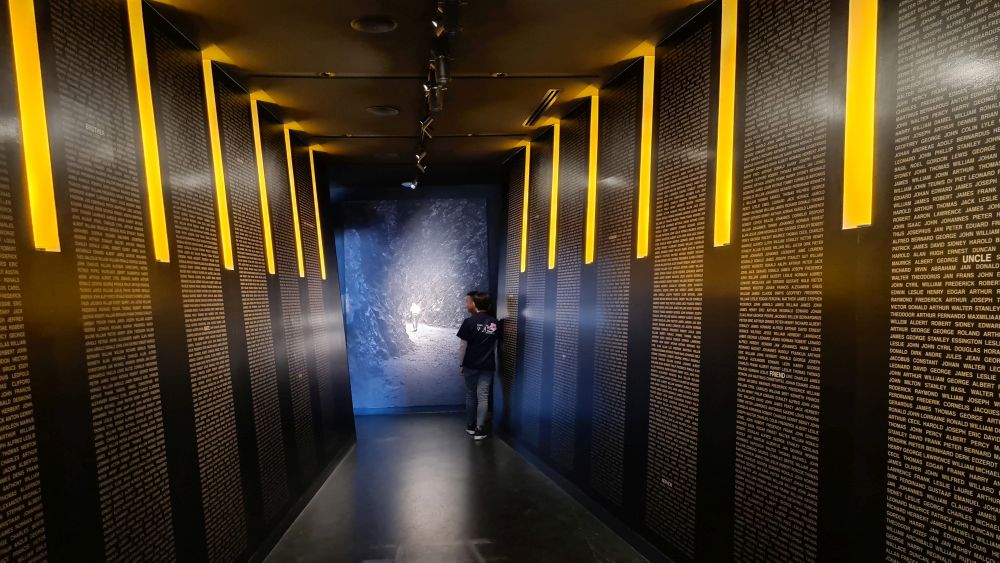
Review of Thailand Journey’s Death Railway tour
I’d certainly recommend this company for this full-day tour. I can only assume any of the other tours they offer would be similarly well-organized. Our pick-up at our hotel was on time, the guide knew his stuff, but also knew when he’d given enough information, and he was responsive to our needs as well. The driver was careful for a whole day of driving interspersed with waiting. It was a long day, but for history enthusiasts like me, it was well worth it: a perfect day trip.
The Burma-Thai Railway is just one tiny piece of a far larger historical puzzle – the story of World War II in Asia. Yet I found the story compelling: the resilience of the victims of Japanese imprisonment, the superhuman demands that they met in building this rail line so quickly, and the tragedy of the number of deaths at Japanese hands.
How to get to these sights
Of course, there are plenty of other companies doing similar day tours from Bangkok, either private, like we did, or as small-group tours. There are also lots of other things to do in Kanchanaburi.
While signing up for a tour like we did would be the easiest way to see these sights, there are other ways to visit at least some of them.
Kanchanaburi
To travel from Bangkok to Kanchanaburi you can take the Burma-Thailand Railway from Thonburi Station in Bangkok. It leaves twice a day and takes about two and half hours. Or rent a car and drive, which will take about three hours.
Within Kanchanaburi it’s about a 20-minute walk between the cemetery and the museum. The bridge is very near the museum.
Krasae Cave
To get to Krasae Cave, you can take the train. There are two a day, and it’s the same train whether you’re traveling with a tour or on your own. Or you can reach it by car.
Hellfire Pass
To get to Hellfire Pass is somewhat more complicated:
- If you are traveling on your own by train, you’ll need to skip the cave and continue to the Nam Tok station. Take a taxi from there to the Hellfire Pass museum. (Tip: Download and set up the Grab app before you go. It makes it very easy to find and pay for a taxi.) Since there are only two trains a day, you’ll probably need to stay overnight.
- If you’re on a tour, it’ll probably include taking the train only as far as Krasae Cave and being picked up by your driver there.
- If you’re in a rental car, you’ll need to skip the train ride. Just drive from Kanchanaburi to the cave and then to Hellfire Pass.
If you’re going to be in Bangkok, first read about the best temples in Bangkok and Chinese temples in Bangkok.
Where to stay
Without a tour, you’ll end up needing to stay somewhere overnight. The most logical places would be Kanchanaburi or at one of the hotels near Hellfire Pass Museum.
And if you still haven’t booked your hotel in Bangkok, read my review of 10 Bangkok hotels I’ve actually stayed in.
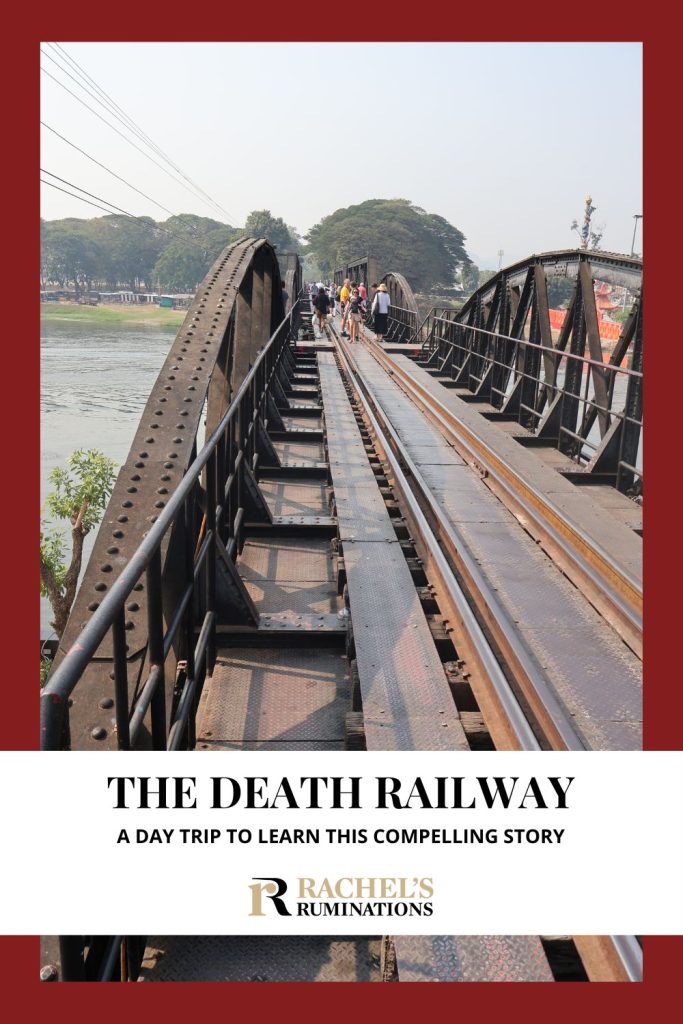
My travel recommendations
Planning travel
- Skyscanner is where I always start my flight searches.
- Booking.com is the company I use most for finding accommodations. If you prefer, Expedia offers more or less the same.
- Discover Cars offers an easy way to compare prices from all of the major car-rental companies in one place.
- Use Viator or GetYourGuide to find walking tours, day tours, airport pickups, city cards, tickets and whatever else you need at your destination.
- Bookmundi is great when you’re looking for a longer tour of a few days to a few weeks, private or with a group, pretty much anywhere in the world. Lots of different tour companies list their tours here, so you can comparison shop.
- GetTransfer is the place to book your airport-to-hotel transfers (and vice-versa). It’s so reassuring to have this all set up and paid for ahead of time, rather than having to make decisions after a long, tiring flight!
- Buy a GoCity Pass when you’re planning to do a lot of sightseeing on a city trip. It can save you a lot on admissions to museums and other attractions in big cities like New York and Amsterdam.
- Ferryhopper is a convenient way to book ferries ahead of time. They cover ferry bookings in 33 different countries at last count.
Other travel-related items
- It’s really awkward to have to rely on WIFI when you travel overseas. I’ve tried several e-sim cards, and GigSky’s e-sim was the one that was easiest to activate and use. You buy it through their app and activate it when you need it. Use the code RACHEL10 to get a 10% discount!
- Another option I just recently tried for the first time is a portable wifi modem by WifiCandy. It supports up to 8 devices and you just carry it along in your pocket or bag! If you’re traveling with a family or group, it might end up cheaper to use than an e-sim. Use the code RACHELSRUMINATIONS for a 10% discount.
- I’m a fan of SCOTTeVEST’s jackets and vests because when I wear one, I don’t have to carry a handbag. I feel like all my stuff is safer when I travel because it’s in inside pockets close to my body.
- I use ExpressVPN on my phone and laptop when I travel. It keeps me safe from hackers when I use public or hotel wifi.


